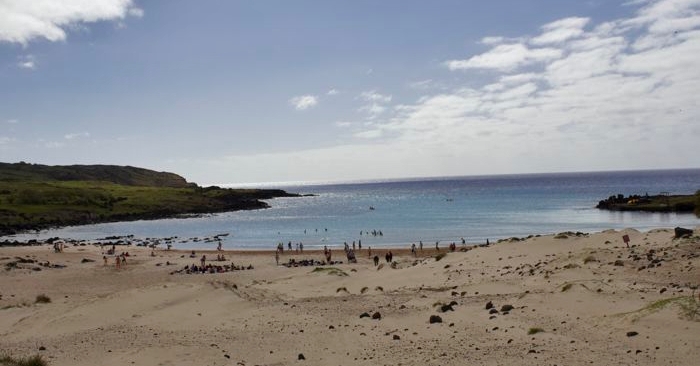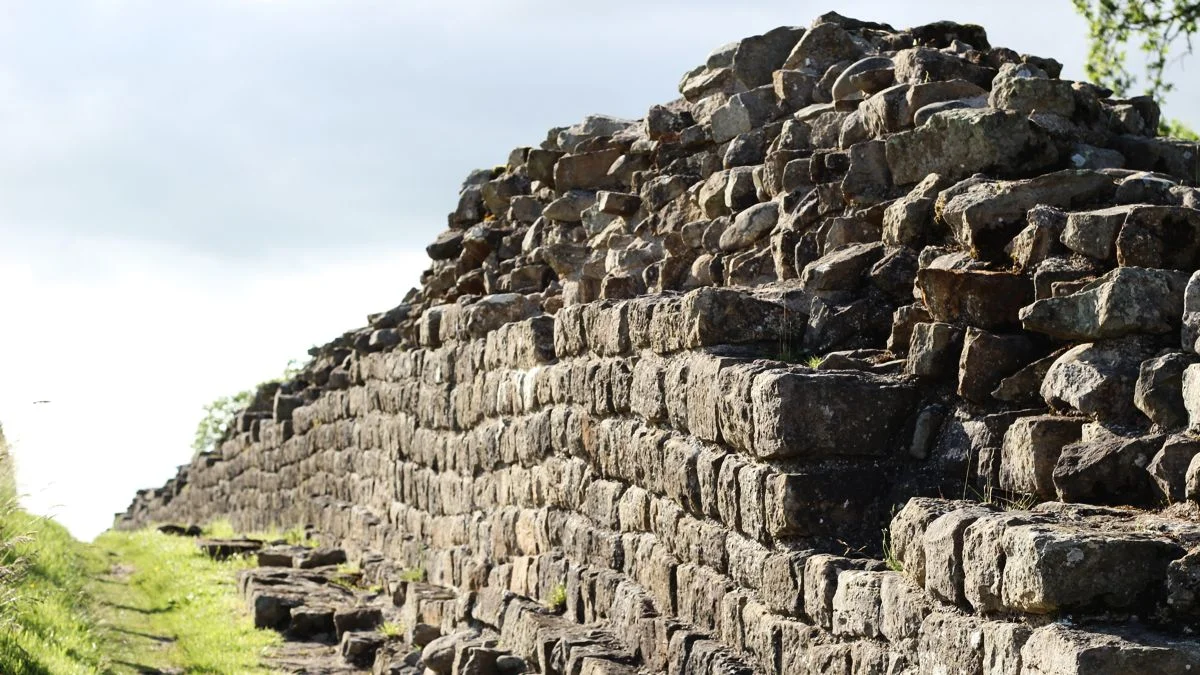Tuesday, 02-09-2014. Day 14.
Big Heads and Magic Rocks
How great is Easter Island? Pretty damn great.
Behind the ahu at Tongariki.
All night we were regaled by the sound of barking dogs and palm trees shaking in the strong winds. There was no heat in our room, and the air was pretty chilly when we woke up. The sun doesn't rise until after 7:00 a.m. (which was weird after days of 5:30 a.m. and 6:30 a.m. sunrises), and when I opened the door to see how warm it was outside, a cat almost came into our room. The girls named her Blaze and she would haunt our doorstep, meowing loudly at sunrise, each day we were there.
Hi. I'm here for the food and the snuggles.
Along with Blaze, the cabaña had a dog (the girls called him Buddy, but his real name was Pulgoso, which means “he has fleas” or something close) that the girls loved to play with.
We hadn't arranged a tour before we arrived on the island, so as we waited for breakfast to be delivered, we did a little research with the fickle 3G connection (that seemed to dwindle down to Edge by mid-morning). We didn't really want to go out with a big tour group — that's not our style. So we were fortunate that Tiare from Easter Island Guides had an open day and was able to take us around the island. We agreed that she'd come pick us up at 10 a.m. and give us a tour of the island for the day. She was a fantastic tour guide (read our review on TripAdvisor).
Pro tip: When visiting Easter Island, to save time buy your tickets to the National Park ($60 for adults, $10 for kids) at the airport. They sell them for a short window with all arriving flights. If you don't get them there, you have to get your tickets from the Rapa Nui National Park's main office at Mataveri, which is on the southwestern tip of the island. Rapa Nui National Park is a UNESCO World Heritage Site (the second one we've visited on our adventure).
Rano Raraku
After we got our tickets, we drove back along the South shore toward Rano Raraku, the quarry where all the moai were carved before they were transported across the island and positioned on an ahu (a platform made of stones) to watch over their people. Tiare told us that of the 887 moai on the island, there were about 400 in Rano Raraku (397 to be precise).
Eternal vigilance.
The moai were carved out of volcanic tuff, which is hardened, compressed volcanic ash. The Rapa Nui used basalt tools to hammer away at the rock, eventually cutting the monolith loose. Then they stood it up in a deep pit so they could finish carving the back and refining some of the details. It is estimated that it took one year for each moai just to carve them.
During the war between the Rapa Nui tribes that started in 1680, all the moai were pushed over and many were damaged. All the standing moai that can be seen on Easter Island have been restored by archaeologists.
Faceplant.
El Gigante
Although still uncarved at Rano Raraku, this moai, nicknamed El Gigante, would have been the largest stone head ever erected on the island.
El Gigante would have towered over the others at nearly 22 meters high and weighing in at an estimated 200 tons. Tiare told us that this was the last moai to be carved before war broke out.
Crater Lake
Rano Raraku is a volcanic crater that also features one of the island's three crater lakes.
There are no rivers on Easter Island, so these crater lakes are some of the few sources of fresh water. They are also a good place to find mosquitoes, which were pretty plentiful on the island and spread the viral Dengue fever and Zika fever (which we'd never heard of prior to this visit).
Tongariki
We left Rano Raraku and drove down to Tongariki, which is one of the more iconic images from the island. That's the place where 15 moai stand in a line on top of an ahu.
With a few exceptions, all the moai on the island face inward. Their role was to act as protectors and guardians of their people, keeping a watchful eye out for trouble.
The area in front of the ahu was often a flat plain where ceremonies were held. Behind the ahu, the Rapa Nui prepared the dead for funeral rites and had burial grounds.
As we left Tongariki, a whole tour of high school kids from Chile arrived. I thought that was a pretty cool school outing — it would be like taking high schoolers from Los Angeles to Hawaii for a field trip. The kids dressed just like high school kids in the U.S., and a good third of them carried GoPro cameras.
But again, Tiere's timing helped us avoid long lines and big crowds.
Te Pito Kura
We continued along the road along the southern side of the island. We stopped at one point to let a group of horses who were fighting in the road pass us by. Tiere called them the dogs of Easter Island; they were really everywhere, even in Rano Raraku, where they walked over the fallen moai, damaging the monoliths.
We stopped to see some petroglyph carvings before we arrived at Te Pito Kura, where there was a huge, round, magnetic rock.
This smooth, polished rock was thought to have been brought to the island by the first Rapa Nui king around 900 C.E. because it was a source of mana, which was a magical power so sought after by the Rapa Nui people that it also drove their need to erect the moai. This iron-rich rock is infamous for making compass needles behave oddly, and there's no other rock like it on the island.
Near the magnetic rock, we saw this poor toppled moai, named Paro. It is the largest moai that was transported from Rano Raraku and placed on an ahu. From the left you can see the flat ahu, then the moai itself face down, then the pukao, or topknot, that sits on top of some of the moai, The pukao are all made from a type of rock known as red scoria, which was quarried mainly at Puna Pau on the island's southwest side, a good distance from Rano Raraku.
Paro is thought to be the last moai to be toppled, and it is believed that British explorer Captain Cook actually saw it standing in 1774.
Anakena
We moved up the road to Anakena, which is thought to be the place where the first king of the Rapa Nui landed about 900 C.E., although there is debate among scientists about the landing place and the date when the first people arrived on the island.
Behind the moai at Anakena. Note the partially carved moai head used in the ahu. Our guide called this the "punished moai."
The beach at Anakena, one of two beaches on Easter Island, is surrounded by palm trees transplanted from Tahiti. While we were there, construction of a series of Polynesian-themed buildings was going on. When finished (“any day now,” they told us), it will house the vendors who sell trinkets and the restaurant that's located on the beach.
The inviting beach. Much to the kids' disappointment, we didn't get a chance to go swimming.
After Anakena, we went back to our hotel and arranged for dinner at Kotaro, a Japanese restaurant considered by many to be the best on the island. It was quite delicious.
Notable Statistics
Hours spent on tour: 7
UNESCO World Heritage Sites visited: 1
Tourists taking pictures with iPads: 2
Stray dogs seen: numerous
Stray cats seen: 2
Easter Island Taxis taken: 2

Tom Fassbender is a writer of things with a strong adventurous streak. He also drinks coffee.





























